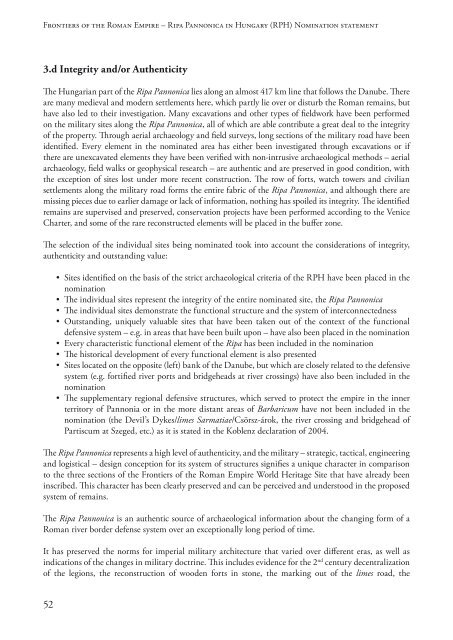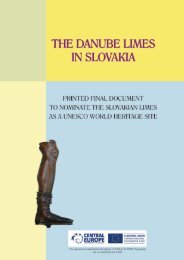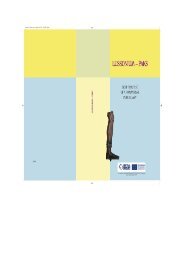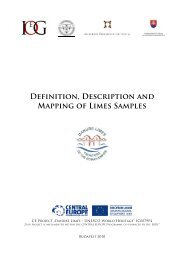the PDF version! - Danube Limes
the PDF version! - Danube Limes
the PDF version! - Danube Limes
You also want an ePaper? Increase the reach of your titles
YUMPU automatically turns print PDFs into web optimized ePapers that Google loves.
Frontiers of <strong>the</strong> Roman Empire – Ripa Pannonica in Hungary (RPH) Nomination statement<br />
3.d Integrity and/or Au<strong>the</strong>nticity<br />
The Hungarian part of <strong>the</strong> Ripa Pannonica lies along an almost 417 km line that follows <strong>the</strong> <strong>Danube</strong>. There<br />
are many medieval and modern settlements here, which partly lie over or disturb <strong>the</strong> Roman remains, but<br />
have also led to <strong>the</strong>ir investigation. Many excavations and o<strong>the</strong>r types of fieldwork have been performed<br />
on <strong>the</strong> military sites along <strong>the</strong> Ripa Pannonica, all of which are able contribute a great deal to <strong>the</strong> integrity<br />
of <strong>the</strong> property. Through aerial archaeology and field surveys, long sections of <strong>the</strong> military road have been<br />
identified. Every element in <strong>the</strong> nominated area has ei<strong>the</strong>r been investigated through excavations or if<br />
<strong>the</strong>re are unexcavated elements <strong>the</strong>y have been verified with non-intrusive archaeological methods – aerial<br />
archaeology, field walks or geophysical research – are au<strong>the</strong>ntic and are preserved in good condition, with<br />
<strong>the</strong> exception of sites lost under more recent construction. The row of forts, watch towers and civilian<br />
settlements along <strong>the</strong> military road forms <strong>the</strong> entire fabric of <strong>the</strong> Ripa Pannonica, and although <strong>the</strong>re are<br />
missing pieces due to earlier damage or lack of information, nothing has spoiled its integrity. The identified<br />
remains are supervised and preserved, conservation projects have been performed according to <strong>the</strong> Venice<br />
Charter, and some of <strong>the</strong> rare reconstructed elements will be placed in <strong>the</strong> buffer zone.<br />
The selection of <strong>the</strong> individual sites being nominated took into account <strong>the</strong> considerations of integrity,<br />
au<strong>the</strong>nticity and outstanding value:<br />
• Sites identified on <strong>the</strong> basis of <strong>the</strong> strict archaeological criteria of <strong>the</strong> RPH have been placed in <strong>the</strong><br />
nomination<br />
• The individual sites represent <strong>the</strong> integrity of <strong>the</strong> entire nominated site, <strong>the</strong> Ripa Pannonica<br />
• The individual sites demonstrate <strong>the</strong> functional structure and <strong>the</strong> system of interconnectedness<br />
• Outstanding, uniquely valuable sites that have been taken out of <strong>the</strong> context of <strong>the</strong> functional<br />
defensive system – e.g. in areas that have been built upon – have also been placed in <strong>the</strong> nomination<br />
• Every characteristic functional element of <strong>the</strong> Ripa has been included in <strong>the</strong> nomination<br />
• The historical development of every functional element is also presented<br />
• Sites located on <strong>the</strong> opposite (left) bank of <strong>the</strong> <strong>Danube</strong>, but which are closely related to <strong>the</strong> defensive<br />
system (e.g. fortified river ports and bridgeheads at river crossings) have also been included in <strong>the</strong><br />
nomination<br />
• The supplementary regional defensive structures, which served to protect <strong>the</strong> empire in <strong>the</strong> inner<br />
territory of Pannonia or in <strong>the</strong> more distant areas of Barbaricum have not been included in <strong>the</strong><br />
nomination (<strong>the</strong> Devil’s Dykes/limes Sarmatiae/Csörsz-árok, <strong>the</strong> river crossing and bridgehead of<br />
Partiscum at Szeged, etc.) as it is stated in <strong>the</strong> Koblenz declaration of 2004.<br />
The Ripa Pannonica represents a high level of au<strong>the</strong>nticity, and <strong>the</strong> military – strategic, tactical, engineering<br />
and logistical – design conception for its system of structures signifies a unique character in comparison<br />
to <strong>the</strong> three sections of <strong>the</strong> Frontiers of <strong>the</strong> Roman Empire World Heritage Site that have already been<br />
inscribed. This character has been clearly preserved and can be perceived and understood in <strong>the</strong> proposed<br />
system of remains.<br />
The Ripa Pannonica is an au<strong>the</strong>ntic source of archaeological information about <strong>the</strong> changing form of a<br />
Roman river border defense system over an exceptionally long period of time.<br />
It has preserved <strong>the</strong> norms for imperial military architecture that varied over different eras, as well as<br />
indications of <strong>the</strong> changes in military doctrine. This includes evidence for <strong>the</strong> 2 nd century decentralization<br />
of <strong>the</strong> legions, <strong>the</strong> reconstruction of wooden forts in stone, <strong>the</strong> marking out of <strong>the</strong> limes road, <strong>the</strong><br />
52











